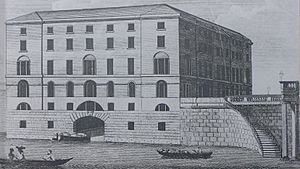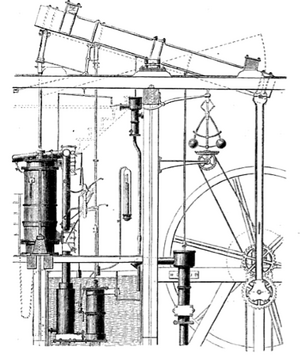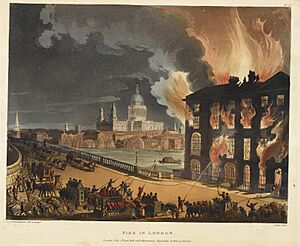Albion Mills, Southwark facts for kids
Quick facts for kids Albion Mills |
|
|---|---|

Albion Flour Mills
|
|
| General information | |
| Town or city | Christchurch, Surrey |
| Country | Great Britain |
| Coordinates | 51°30′30″N 0°6′10″W / 51.50833°N 0.10278°W |
| Opened | 1786 |
| Closed | 1791 |
| Technical details | |
| Floor count | Five floors |
| Design and construction | |
| Architect | Samuel Wyatt |
| Civil engineer | Matthew Boulton, James Watt |
The Albion Mills was a very important flour mill in London. It was special because it used a steam engine to grind flour. This mill was located near Blackfriars Bridge in Southwark. Plans for the mill started around 1783. It was finished in 1786 but sadly burned down in 1791. Many old drawings of the mill are now kept in the Birmingham Central Library.
What Was Inside the Mill?
The famous architect Samuel Wyatt designed the building. The mill's powerful engines got their water directly from the River Thames. At the time, these engines were considered the best and strongest ever made by the Soho Manufactory.
Most of the mill's parts, like its wheels and shafts, were made of strong iron. Some of the cogs (the toothed wheels that transfer power) were made of hard wood, while others were made of cast iron. The teeth of these gears were carefully shaped.
The mill had a special double engine that produced 50 horsepower. This engine powered 20 pairs of millstones. Each pair could grind about nine bushels of corn every hour! The engine also helped with other tasks. It lifted the corn, cleaned it, sifted the flour, and even lowered it into barges. This made the whole process much faster and more efficient.
A Brief History of the Mill
The Albion Mills was built in 1786 by Matthew Boulton. He had help from London's financial experts and a musician named Joah Bates. Bates invested a lot of his own money into the project. This mill was the very first commercial flour mill in the United Kingdom to be powered by steam.
James Watt, who worked with Boulton, was personally hired to build the steam engine for the mill. Many people, including important figures like Sir Joseph Banks, came to watch Watt's engine being tested. There were some early problems with parts like the "sun and planet gear" and the piston rods. However, these issues were fixed by April 1786.
Building the mill cost a lot more money than first expected. Watt worried that the mill might not make a profit. He was sure the engines and machinery would work perfectly. But he was concerned that the people managing the mill might not be good at business. In September 1786, a special visitor, the Duke of Milan, came to see the mills.
By 1789, a second engine had been added to the mill. The business started to do very well. By June 1790, the mill was selling £6,800 worth of flour each week. However, there were still problems with how the mill was run and maintained. Boulton was not completely happy with the results.
The Great Fire of 1791
On March 2, 1791, at 6:30 in the morning, a terrible fire broke out. The fire completely destroyed the building within just two hours. This was a huge blow for Joah Bates, who had invested so much. Several houses near the mill also burned down. The damage was estimated to be around £150,000. Over 500 people lost their jobs because of the fire.
Many people suspected that someone had purposely started the fire. However, the mill's manager, Wyatt, and engineer Rennie, said it was an accident. They thought it was caused by a lack of grease on a corn machine near the kiln. After the Albion Mills burned down, other mills in places like Blackwall and Poplar, which had been closed, started working again.
Some rival mill owners in London were happy about the fire. The Albion Mills Company had almost complete control over the London flour market. Plans to build a new engine and mill were eventually stopped. The remains of the old mill were turned into houses. The Albion Mills building became a symbol of the coming Industrial Revolution for London. Some people believe its burnt shell inspired William Blake's famous line "dark satanic mills" in his poem And did those feet in ancient time. Many important drawings of the Albion Mills are now kept in the Boulton & Watt Archive in Birmingham Central Library.




